The design and construction of an autonomous water supply and sewerage system is a time-consuming, physical and financial task. At the stage of mine development, the choice and installation of casing is of great importance. A well without a casing is characterized by a short service life, low quality of produced water, there is no strengthening of the walls of the structure, which threatens to collapse.
Purpose and scope of well casing
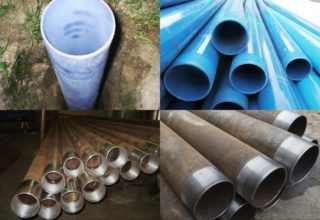
First of all, you need to decide what a casing is and for what purposes it is used. This is a special column equipped with a reinforced casing, the main task of which is to strengthen the internal structure of a hydraulic structure. As a rule, more than one functional element is installed in a deep well shaft. They are connected to each other, and the seams are treated with a sealant to obtain a single casing.
The wall thickness of the casing rings should be determined by the type and characteristics of the structure, as well as by the material used for the casing walls.
Products made of concrete and metal are characterized by a large wall thickness, diameter and length, in comparison with plastic parts. To create a tight connection between the elements, the end of one pipe always has a sleeve. The second end is equipped with a ring that protects the thread from damage.
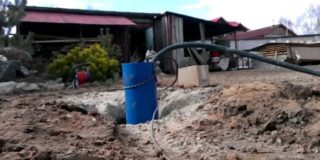
Source casing pipes are required to perform the following tasks:
- Protect the water pump or the pumping system installed in the shaft from possible contamination and mechanical damage.
- Ensure the integrity of the water intake point throughout the entire period of operation. The products are characterized by increased strength, resistance to deformation and damage.
- Protect the well from high soil pressure.
- Prevent the seepage of sewage or groundwater into the well, which threatens with water pollution and contamination of it with pathogens.
It is necessary to give preference to the threaded method of connection, otherwise it is almost impossible to achieve reliable sealing of the casing pipes.
Pipe types and selection criteria
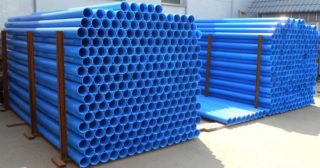
Casing pipes are divided into several types depending on the material of manufacture:
- plastic (PVC, PVC-U);
- metal;
- asbestos-cement.
Each material has a certain service life, and also affects the quality of well water. To determine the choice of material, you need to study in more detail the features of each.
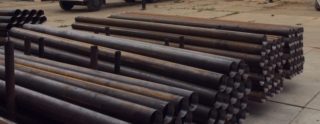
Steel for strengthening the casing channel is used quite often, especially in artesian wells, characterized by great depth. Steel products are durable and reliable, with proper installation and maintenance, they can last for several decades. Sewer steel well casing is common.
The movement of soil layers negatively affects the design. Also, the material is prone to corrosion, due to which the quality of the well water deteriorates. To avoid this problem, stainless steel should be preferred, but well completion costs will increase significantly.
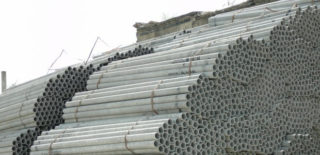
Long service life and excellent performance characteristics are characteristic of asbestos-cement products. However, there is a fairly extensive list of disadvantages:
- Insufficient strength at great depths, where the pressure of the soil layers reaches critical levels.
- Asbestos, despite being bound to cement, over time can begin to decompose into components that have a negative impact on the quality and taste of water.
- Due to the large wall thickness of the casing rings, the borehole diameter needs to be drilled more, which negatively affects the cost of work.
Asbestos-cement products are best used for casing wells with a depth of no more than 15 meters.
Well casing with plastic pipes is increasingly common. This is due to the fact that products made of low-pressure polyethylene or polyvinyl chloride have excellent qualities used in various communications.
- In comparison with previous analogs, the cost of products is much lower.
- The material is not afraid of corrosion, plaque does not form on its surface.
- Products do not decompose, do not adversely affect water quality.
- Due to its high strength and reliability, a long service life is ensured.
- The use of modern methods of joining parts ensures the tightness of the channel.
- Due to its low weight, the casing is easier to mount.
The use of plastic pipes is limited in depth. As a rule, they are used for wells up to 50 meters. The diameter depends on the volume of water consumed and the depth.
Installation features

Installation of casing parts is carried out by drilling the soil with a drill. The bit diameter should be less than the casing diameter. Then it is taken out of the ground and the dirt is removed. The casing is run when the well depth reaches 2 meters. Further, drilling should be carried out together with the casing until the moment, until the aquifer is overtaken.
The classic version of the casing is as follows:
- The filter for coarse cleaning of well water is a wire or stainless steel mesh.
- A bottom filter made of gravel. Protects water from contamination that can penetrate into the source from a greater depth.
- A sealed head that prevents contamination from entering the well from the outside. Its attachment is accompanied by the formation of negative pressure, which leads to an increase in the flow of water. To increase the negative pressure, the head is cemented.
It is not recommended to consume water from a freshly drilled source for food purposes. Having installed the pumping equipment, they pump out the liquid from the shaft for the maximum possible expansion.
Choosing the right casing for a well is guided by a simple but proven combination of quality and price. Due to these parameters, it is determined how long the structure will work.
Wells with great depth are recommended to be made out with metal products equipped with external and internal threads. If the depth of the well shaft is less than 50 meters, preference is given to the budget analogue - plastic pipes. Asbestos-cement products are installed at a well depth of no more than 15 meters, otherwise the material may not withstand the pressure exerted by the soil layers.








